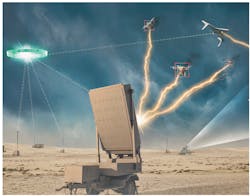Air Force approaches industry for enabling technologies in high-power electromagnetic and microwave weapons
KIRTLAND AIR FORCE BASE, N.M. – U.S. Air Force high-power electromagnetic (HPEM) weapons researchers are asking industry to develop new HPEM weapons concepts, materials, components, and compact power topologies for future military programs.
Officials of the Air Force Research Laboratory Directed Energy Directorate at Kirtland Air Force Base, N.M., issued a broad agency announcement on Friday for the Advanced Electromagnetic Technology (AET) project.
This project also seeks to evaluate and capitalize on advances in prime power technologies to optimize size, weight, and power (SWaP) requirements for future HPEM weapon systems.
The five-year AET project revolves around six enabling technologies: repetitive pulsed power; charged particle beam interactions; compact low-duty-factor prime power HPEM material and plasma technology; HPEM fundamental research; and solid-state-HPEM.
Related: Air Force seeks to apply high-power electromagnetic technologies to EW and cyber warfare
Repetitive pulsed power seeks to advance compact pulsed-power technologies that enable compact, pulsed power systems suitable to drive high-power electromagnetic sources.
These enabling technologies include Marx banks, pulsed forming networks, pulse forming lines, linear transformer drivers, hybrid pulsed power topologies, nonlinear transmission lines, solid state switches, gas switches, capacitors, transformers, insulating dielectrics, varactors, resistors, magnetic and dielectric conducting and structural materials.
This research for high-power microwave weapons and similar systems also will develop prime power sources and strategies for compact energy storage, charging, discharging, and power conditioning of pulsed power systems for manned and unmanned aircraft. The research will include computer analysis and modeling of pulsed and prime power systems and components to predict and evaluate performance, operational suitability, and lifetime.
Charged particle beam interactions involves enabling technologies for high-energy particle beam weapons that can disable or destroy enemy electronic components and systems. This research effort can be divided into two components: the first component focuses on understanding and characterizing the effects that high energy particle beams can have on electronic systems, and the second component entails designing and building an accelerator with which to perform effects tests.
Compact low-duty-factor prime power seeks to develop compact prime power technologies for intermittent, high-power, pulsed operation, and high efficiency to function as compact energy storage and power conditioning sources for directed-energy systems like high-power microwave weapons and laser weapons.
HPEM material and plasma science and technology seeks to understand how millimeter wave radiation interacts with high-temperature materials to develop materials for power beaming applications.
HPEM fundamental research will work on the interactions of materials for next-generation high-power microwave weapons, including modeling, and testing of materials heated using high-power microwave or millimeter-wave radiation.
Solid-state HPEM seeks to develop nonlinear-transmission-line or other solid-state high power electromagnetic weapon concepts for future aircraft weapons. The effort will look into ruggedization, lifetime tests on system components, pulsed power, prime power sources, and antennas.
Companies interested should submit proposals no later than 17 Aug. 2021 via the U.S. Department of Defense Secure Access File Exchange (SAFE) website at https://safe.apps.mil.
If bidders do not have Common Access Cards (CAC), email the Air Force's Pedro Oroyan at [email protected], or Jaclyn Torres at [email protected] to request a “drop off” link to the DoD SAFE website.
Email questions or concerns to the Air Force's Susan Heidger at [email protected]. More information is online at https://sam.gov/opp/187749dbaa4848868dd9409305c4231d/view.
About the Author
John Keller
Editor-in-Chief
John Keller is the Editor-in-Chief, Military & Aerospace Electronics Magazine--provides extensive coverage and analysis of enabling electronics and optoelectronic technologies in military, space and commercial aviation applications. John has been a member of the Military & Aerospace Electronics staff since 1989 and chief editor since 1995.
